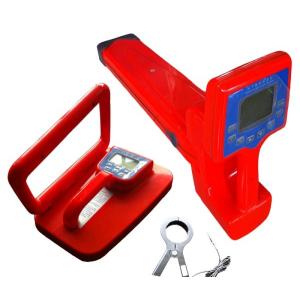Multifunctional 10W Portable Gas Detector 360 Less Than 60db Noise
Add to Cart
The 360 Multifunctional Underground Pipeline Detector consists of a
transmitter, a receiver and accessory for the positioning of
underground pipeline routing, buried depth measurements and long
distance tracking, and the measurement of pipeline fault points.
360 multi-function underground pipeline detector using a multi-coil
electromagnetic technology to improve the accuracy of the pipeline
positioning depth and target pipeline identification capabilities
in the pipeline-intensive areas can also accurately track the
target pipeline and positioning. Therefore, 360 multi-functional
underground pipeline detector in telecommunications, China Netcom,
mobile, China Unicom, Railcom, electricity, water, gas,
geophysical, petrochemical and municipal industries have been
widely used.
The 360 Multifunctional Underground Pipeline Detector offers a wide
range of optional accessories, which increases their use and
extends their range of applications.
Functions
1, the determination of underground pipeline routing
2, the determination of underground pipeline depth
3, multi-pipeline case of the target pipeline identification
4, detect and locate the pipeline insulation fault point
Features
1, the use of advanced signal processing technology, integrated
circuit components to achieve excellent test performance.
2, a variety of measurement signals to send:
(1) injection method: for the injection point of the pipeline.
(2) clamp method: for the test line has a section exposed, easy to
clamp the clamp line.
(3) induction method: for no injection point or no exposed
pipeline.
3, a variety of measurement frequency: 480Hz, 7.7KHz, 31KHz and
61KHz four active frequency and power cable 50Hz passive frequency;
the user can choose according to the different environment (need
special measurement frequency in the order contract Bright).
4, to improve the efficiency of the test different positioning mode
and function:
(1) Peak mode: The position of the route is determined by measuring
the maximum value of the signal.
(2) valley mode: by measuring the minimum value of the signal to
determine the location of the route.
(3) routing orientation: intuitive, quickly indicate the direction
of routing.
(4) Insulation fault measurement (FF): Measure and locate the fault
point caused by deterioration of the pipeline insulation.
(5) Stethoscope: through the auscultation from the many lines to
identify the signal loaded by the pipeline.
5, auxiliary functions:
(1) Receive Gain Auto Adjustment: Automatically adjusts the gain of
the receiver to make the receiver in an optimized state,
eliminating the need for manual adjustment.
(2) sound function: the receiver through the tone changes
intuitively reflect the measured signal size.
(3) pipeline state detection: the transmitter in the injection
mode, the first test of the pipeline insulation resistance,
residual voltage, and then apply the signal to the target pipeline.
When the insulation resistance on the pipeline is small (near the
ground short) the transmitter will automatically exit the mode,
when the residual voltage is large when the transmitter alarm, the
operator should immediately stop the signal load, turn off the
transmitter.
(4) battery power detection: the battery power of real-time
detection, when the battery is low to the protection value will
automatically alarm shutdown.
(5) power-saving features: the transmitter boot about 30 seconds
without other keys, the receiver boot operation, if 10 minutes or
so no other press the key, the machine will automatically shut down
to save battery power.
Transmitter technical indicators
Injection method: 480 Hz, 7.7 kHz, 31 kHz and 61 kHz
Sensing mode: 31KHz, 61KHz
Clamping method: 31KHz
Fault finding The output voltage 0-400Vp-p varies according to
insulation
Output waveform Sine wave
power supply: 11.1VDC 4.4AH lithium battery
Maximum output power: 10W
Receiver Specifications
Power consumption: <1.0W
power supply : 11.1VDC 1.8AH lithium battery
Maximum test line depth: 4.5 m (under normal circumstances)
Test line buried depth error: ± 0.05h ± 5cm (h is the depth of the
pipeline)
Test route routing error :≤ 5cm
Use the injection method to test the length of the pipeline route
and the buried depth
Not less than 10Km (under normal circumstances)
Using Induction Method to Test Line Routing and Buried Effective
Length
Not less than 3Km (under normal circumstances)
Using clamp method to test line routing and buried depth effective
length
Not less than 6Km (under normal circumstances)
Insulation fault detection
Not less than 2MΩ
Note: Under normal circumstances, the pipeline under test in the
above measurement range without insulation failure and other
interference.
Environmental requirements
Operating temperature:-20 ° C to + 55 ° C
storage temperature:-40 ℃ -70 ℃
Relative humidity: 10% to 90%
Atmospheric pressure:86 ~ 106KPa
Environmental noise:≤ 60dB



